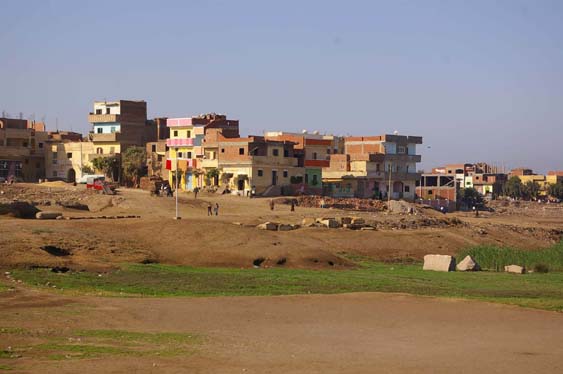Saïs Report, 2007
Season Reports
Saïs Report, 2007
Future Work at Sais

The village of Sa el Hagar on the site of ancient Sais.
Between 2002-2007 the work at Sais was funded by a major grant from the Arts and Humanities Research Council in the UK. Changes in the way that the British Academy funds the Egypt Exploration Society and in the priorities of the AHRC mean that at the moment there is no further funding or work at Sais. It will be possible to undertake some winding up seasons with small amounts of funding from the British Academy and dedicated donations from the Friends of the Petrie, Birkbeck College and Jacky Finch. In the meantime the priority is on the publication of the fieldwork as quickly as possible.
Sais still has archaeological potential, as shown by our ten years of work there. The highlights of our work are :
• the discovery of the Neolithic and Predynastic area. The Neolithic area is so far the only accessible site in the floodplain, although it is under threat from development.
• the identification of a major settlement site at Kom Rebwa with a Ramesside town buried underneath it and the potential for understanding the town stratigraphy going back to the Old Kingdom and Early Dynastic period
• the Saite dumps at the edge of the Great Pit. They contain further information about the trade links of Egypt in Dynasty 26 and the shattered fragments of the once glorious capital city.
• the location of faience and pottery kiln sites on the western side of the Pit.
• the identification of the Roman and Christian areas of the town.
It may, however, be time for the project team to move on and extend and expand upon information about the Delta at another place.
As always we would like to record our thanks to all those who have helped us, in particular the Tanta Office of the SCA, without whom the work could not have been carried out. The police and tourist police in Bassioun and Sa el-Hagar have helped and facilitated the work throughout the whole of the ten years. I am indebted to the people of Sa el-Hagar for their kindness during our work. Finally, I would like to thank the el-Bishe family for taking good care of the teams, providing workers and providing a pleasant and interesting living environment.
Over the years 52 team members have taken part in the work at Sais. They have come from as far afield as Canada, Japan, Australia, USA, Italy, Spain, Germany, Austria, Greece, Poland, France, Ireland, Netherlands as well as the UK and, of course, Egypt. Some have gone on to real jobs within and outside archaeology or Egyptology, some have completed PhD degrees, some have even returned more than once to the site. Thank you all for your work past and present.
Penny Wilson
Durham, May 2008.

The market at Sa el Hagar (in the centre).
